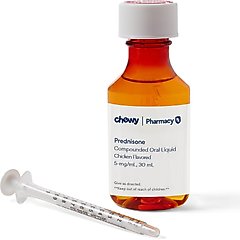Dog Stroke Symptoms: What to Know for Your Pup

Photo by Chalabala/iStock/Getty Images Plus
A stroke—defined as when brain function is suddenly disrupted by a clot or a bleed—can be frightening, whether it happens to a person or a pet.
The good news is that strokes in dogs are relatively uncommon. Still, it’s important to understand what a stroke is, what stroke symptoms look like in a dog, and what might increase your dog’s risk.
Key Takeaways:
- Strokes aren’t common in dogs, but it’s important to know the signs.
- This neurological event happens when blood flow to part of the brain is disrupted.
- Symptoms of a stroke include confusion or disorientation, loss of balance, and behavior changes.
- If you’re worried your dog has had a stroke, you should visit an emergency veterinarian immediately.
Can Dogs Have Strokes?
Yes, dogs can have strokes, and they’re not so different than those in humans. A stroke occurs when blood flow to part of the brain is disrupted, either due to a clot (an ischemic stroke) or bleeding (a hemorrhagic stroke), explains Fred Wininger, VMD, MS, DACVIM, a veterinary neurologist, neurosurgeon, and owner of The Animal Neurology Center in St. Louis, Missouri.
Dogs can also experience mini strokes, also called transient ischemic attacks (TIAs), which are mild versions of ischemic strokes. A TIA happens when there’s a brief interruption of blood flow to the brain, but unlike a full stroke, the blockage clears on its own.
According to Jamie Richardson, BVetMed, head of veterinary medicine at Small Door Vet, these episodes often resolve within minutes to hours, usually before a pet parent even realizes something has happened.
How Common Are Strokes in Dogs?
Strokes in dogs are less common than in humans, partly because dogs don’t usually develop clogged arteries from high cholesterol, Dr. Wininger explains.
“We see clinical strokes—cases where a dog is brought in specifically for stroke symptoms—perhaps twice a month,” he says. (Don’t let that number worry you, though: Vets see dozens, or sometimes even hundreds, of patients a month, and the most common reasons for canine visits are skin allergies, ear infections, and upset stomachs.)
Still, strokes in dogs may be underdiagnosed, as the signs can be subtle or even absent. In fact, Dr. Wininger says many strokes are discovered during MRIs for unrelated issues.
What Are the Signs of a Stroke in Dogs?
Stroke symptoms in dogs can be subtle and easy to miss. That’s why Dr. Richardson says even brief, sudden changes in balance, coordination, or behavior shouldn’t be ignored.
The signs of a stroke in a dog can vary depending on which part of the brain is affected, Dr. Wininger adds. For example, if the stroke occurs in the cerebellum (the back of the brain), you’re more likely to see balance issues. If it’s in the forebrain, changes in behavior are more common.
Contact your veterinarian right away if you notice any of the following:
- Sudden loss of balance (ataxia)
- Head tilt
- Walking in circles
- Abnormal eye movements
- Collapse
- Confusion or disorientation
- Changes in behavior
- Personality changes
- Difficulty walking
What Causes a Stroke in Dogs?
Most strokes in dogs are considered idiopathic, meaning there’s no clear cause, Dr. Wininger says. However, he notes that certain conditions and risk factors may be associated with strokes in some dogs.
High Blood Pressure
High blood pressure happens when the heart works harder than usual to pump blood through the body. This often occurs when the arteries become too narrow or stiff, which can be caused by other underlying health issues.
Endocrine Disorders
Some hormone-related conditions, like hypothyroidism or Cushing’s disease, may also be connected to strokes in dogs.
Kidney Disease
When the kidneys aren’t working properly, there is a ripple effect on a dog’s overall health—including heart and blood vessel health—which may increase the risk of stroke.
Breed
“Cavalier King Charles Spaniels and Greyhounds have been reported to have more strokes than other breeds,” Dr. Wininger says.
What To Do If Your Dog Is Having a Stroke
If your dog is experiencing a stroke, Dr. Richardson recommends:
- Calling your veterinarian or an emergency animal hospital right away. Be prepared to describe the symptoms you’re seeing and follow their instructions—most will recommend bringing your dog in immediately.
- Not giving your dog any medications unless told to do so by a vet.
- Keeping your dog calm and safe while preparing them for transport. Lie them on a flat surface or towel if they’re unable to walk.
- If your dog is small enough, you can transport them in a dog carrier; if they are larger, make sure they have a comfortable towel or dog blanket and are lying completely flat while en route to the vet clinic.
Recommended Products
How Does Your Vet Diagnose a Stroke?
If your dog shows signs of a stroke, your vet will ask questions to help figure out what’s going on.
“We’ll typically ask for a full medical history including access to toxin exposure, as many things that pets may eat, such as marijuana, can cause neurological issues,” Dr. Richardson says. “We will also run blood work to rule out systemic illness.”
But the only way to accurately confirm a stroke is with an MRI. These are usually done with a veterinary neurologist. Because MRIs are expensive and require anesthesia—and because not all strokes lead to life-altering outcomes—many pet parents choose to forgo that route.
Instead, you might choose to monitor your pet and work with your vet to manage symptoms and underlying conditions.
How Does Your Vet Treat a Stroke?
Doctors can give people “clot-busting” drugs in the first few hours after a stroke, but vets don’t have that option, Dr. Richardson explains.
Instead, stroke treatment in dogs focuses on supportive care, which may include IV fluids, oxygen, medications to reduce brain swelling, and sometimes anti-seizure drugs. Your vet may also work with you to diagnose and treat the underlying cause.
Recommended Products
What Is Your Dog’s Prognosis After a Stroke?
Most dogs who’ve had strokes don’t need special long-term care and recover well.
“Strokes can be scary, but they often have good outcomes,” Dr. Wininger says.
That said, strokes can sometimes be life-threatening, especially if there’s bleeding in the brain or if critical areas are affected, Dr. Richardson says.
And other pups may have mild lasting effects, like a slight head tilt or muscle weakness, without it affecting their daily lives.
FAQs About Dog Stroke Symptoms
Q: Can a dog have a mini stroke?
A: Yes, dogs can have mini strokes, also called transient ischemic attacks (TIAs). These are short interruptions in blood flow to the brain and often resolve on their own.
Q: Can dogs have more than one stroke?
A: Yes, it’s possible for a dog to have more than one stroke. If the underlying cause isn’t identified and treated, there’s a higher chance of another stroke happening down the line.
Q: Which dog breeds are most prone to strokes?
A: According to Dr. Wininger, strokes are most reported in Cavalier King Charles Spaniels and Greyhounds.










